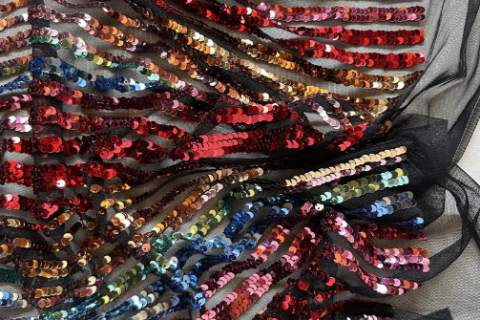Perfectly timed for Fashion Revolution Week, member of the pack, Tyla, wrote us a blog post. It’s all about making the most of your fabric and letting nothing go to waste. There are so many good ideas, and just wait until you see those jungle cushions!
Using Every Scrap
When you buy new fabrics from one of the many wonderful small businesses featured in the packs, don’t waste a shred of material if you can help it. My first ever haystack pack was August 2020. I made the featured pattern, the Leila dress by Marsha Style, in a beautiful drapey floral viscose.
I had lots of awkwardly-shaped but sizable scraps left over, which I used to make a few metres of bias binding to replace the tattered binding and straps on my PJs, a lining and applique details for a sleep mask, and a headscarf. The teeny tiny scraps that couldn’t be sewn into anything went into my ongoing rag rag project, or became stuffing for the little cushions that my guinea pigs love to snuggle on and destroy.
Into the jungle!
Last month, I made use of the pack discount at Grid Fabrics and bought a jungle-themed fat quarter bundle from Grid Fabrics, which included six coordinating prints. I made a trio of simple 40x40cm envelope cushion covers for my bed, and then patchworked the remaining pieces of fabric into two bonus cushion fronts! I used some white cotton voile that I had in my stash to make the backs, but I suppose I could have used the two patchworks to make a single cushion if that wasn’t available. I had some tiny scraps of jungle fabric left over – more on those later.
Oranges & lemons, say the bells of St. Clements…
I also bought 1m each of the orange print and lemon print cotton poplins from Grid Fabrics to make some cushions for my lounge. I also included a pom-pom trim which I think really elevated them, even if it was a pain to sew! Oh, and in case you were wondering, the key to a beautifully plump cushion is to use an insert around 5cm bigger than your cover – these are 45x45cm inside 40x40cm covers.
After making four simple envelope cushion covers (two from each print), I had two large-ish L-shaped offcuts and 70cm of each pom-pom trim left over, and I didn’t want any of it to go to waste. I decided to take my usual approach of finding ways to use up small scraps to a new level: could I make it so that nothing was left?
First, I sewed two pleated face masks (wire & elastic from my stash). I then made two slim scrunchies from some of the long skinny strips that I would usually put in my rag rag. These skinner styles are ideal for me as I have fine hair and find the usual scrunchie patterns online far too big.
Next, I cut out the pocket bags from the orange print for my upcoming Bolt Culottes project (March’s haystack pack pattern). Then, I used the April pack’s tutorial to make two gorgeous fabric vases from the lemon print, which also helped me save two bottles from the recycling.
No scrap left behind
After all this, I still had a few very small scraps left from both the fruit and jungle print cottons. In the past, I may have consigned these to my scrap bin (which I use to stuff cushions for my guinea pigs), but I was on a mission to use it all.
So, I made lavender bags. I even patchworked together seemingly unusable strips into a whole little bag, and used a long strip from the orange print cotton to make hanging loops (fold over to enclose the raw edges and topstitch). I filled them with dried lavender from a friend’s garden, and I’ve hung them in my wardrobe. They smell lovely and deter moths – double win!
I still had the pom-pom trim and some small scraps left, so I made two coasters by gluing pom-poms that I’d cut off the trim onto cardboard, and I glued a circle of fabric underneath to hide the card.
Lastly, I used the remaining little strips of fabric and loose pom-poms to make two rosettes. I think I’ll use these for gifts instead of plastic bows. You can see these in the photo above, next to the face masks and scrunchies.
After all that effort, all I had left was a little jar of really, really tiny scraps that genuinely couldn’t be made into anything – I’ll use these for stuffing. I’m proud of myself for using everything that I could, and it was great to challenge my creativity in this way. It’s proved to me that I can make more use of the fabric that I already have, which is, of course, the most sustainable fabric there is.
You can find Tyla here






















